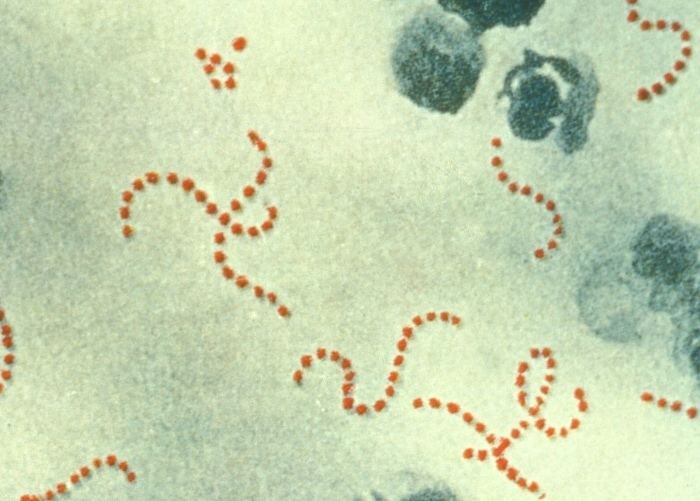Kingdom Eubacteria Order Lactobacillales Rank Species | Phylum Firmicutes Higher classification Streptococcus | |
 | ||
Similar Bacteria, Haemophilus, Neisseria, Moraxella, Proteus | ||
Bacteria streptococcus pyogenes
Streptococcus pyogenes is a species of bacteria. These bacteria are aerotolerant and an extracellular bacterium, made up of non-motile and non-sporing cocci. As expected with a streptococci, it is clinically important in human illness. It is an infrequent, but usually pathogenic, part of the skin flora. It is the predominant species harboring the Lancefield group A antigen, and is often called group A streptococcus (GAS). However, both Streptococcus dysgalactiae and the Streptococcus anginosus group can possess group A antigen. Group A streptococci when grown on blood agar typically produces small zones of beta-hemolysis, a complete destruction of red blood cells. (A zone size of 2–3 mm is typical.) It is thus also called group A (beta-hemolytic) streptococcus (GABHS), and can make colonies greater than 5 mm in size.
Contents
- Bacteria streptococcus pyogenes
- A bacteria comecarne streptococcus pyogenes grupo a
- Methods of transmission
- Serotyping
- Virulence factors
- Lysogeny
- Genome
- Disease
- Bionanotechnology
- Genome editing
- References
Like other cocci, streptococci are round bacteria. The name is derived from the Greek meaning pus(pyo)-forming(genes) chain(Strepto) of berries (coccus), because streptococcal cells tend to link in chains of round cells (see image) and a number of infections caused by the bacteria, produce pus. Streptococci are catalase-negative and Gram-positive. S. pyogenes can be cultured on blood agar plates. Under ideal conditions, it has an incubation period of 1 to 3 days.
An estimated 700 million GAS infections occur worldwide each year. While the overall mortality rate for these infections is 0.1%, over 650,000 of the cases are severe and invasive, and have a mortality rate of 25%. Early recognition and treatment are critical; diagnostic failure can result in sepsis and death.
A bacteria comecarne streptococcus pyogenes grupo a
Method(s) of transmission
Serotyping
In 1928, Rebecca Lancefield published a method for serotyping S. pyogenes based on its M protein, a virulence factor displayed on its surface. Later, in 1946, Lancefield described the serologic classification of S. pyogenes isolates based on their surface T-antigen. Four of the 20 T-antigens have been revealed to be pili, which are used by bacteria to attach to host cells. Over 220 M serotypes and about 20 T serotypes are known.
Virulence factors
S. pyogenes has several virulence factors that enable it to attach to host tissues, evade the immune response, and spread by penetrating host tissue layers. A carbohydrate-based bacterial capsule composed of hyaluronic acid surrounds the bacterium, protecting it from phagocytosis by neutrophils. In addition, the capsule and several factors embedded in the cell wall, including M protein, lipoteichoic acid, and protein F (SfbI) facilitate attachment to various host cells. M protein also inhibits opsonization by the alternative complement pathway by binding to host complement regulators. The M protein found on some serotypes is also able to prevent opsonization by binding to fibrinogen. However, the M protein is also the weakest point in this pathogen's defense, as antibodies produced by the immune system against M protein target the bacteria for engulfment by phagocytes. M proteins are unique to each strain, and identification can be used clinically to confirm the strain causing an infection.
Lysogeny
All strains of S. pyogenes are polylysogenized, in that they carry one or more bacteriophage on their genomes. Some of the phages may be defective, but in some cases active phage may compensate for defects in others. In general, the genome of S. pyogenes strains isolated during disease are >90% identical, they differ by the phage they carry.
Genome
The genome of different strains were sequenced (genome size is 1.8–1.9 Mbp) encoding about 1700-1900 proteins (1700 in strain NZ131, 1865 in strain MGAS5005).
Disease
S. pyogenes is the cause of many important human diseases, ranging from mild superficial skin infections to life-threatening systemic diseases. Infections typically begin in the throat or skin. The most striking sign is a strawberry-like rash. Examples of mild S. pyogenes infections include pharyngitis (strep throat) and localized skin infection (impetigo). Erysipelas and cellulitis are characterized by multiplication and lateral spread of S. pyogenes in deep layers of the skin. S. pyogenes invasion and multiplication in the fascia can lead to necrotizing fasciitis, a life-threatening condition requiring surgery.
Infections due to certain strains of S. pyogenes can be associated with the release of bacterial toxins. Throat infections associated with release of certain toxins lead to scarlet fever. Other toxigenic S. pyogenes infections may lead to streptococcal toxic shock syndrome, which can be life-threatening.
S. pyogenes can also cause disease in the form of postinfectious "nonpyogenic" (not associated with local bacterial multiplication and pus formation) syndromes. These autoimmune-mediated complications follow a small percentage of infections and include rheumatic fever and acute postinfectious glomerulonephritis. Both conditions appear several weeks following the initial streptococcal infection. Rheumatic fever is characterised by inflammation of the joints and/or heart following an episode of streptococcal pharyngitis. Acute glomerulonephritis, inflammation of the renal glomerulus, can follow streptococcal pharyngitis or skin infection.
This bacterium remains acutely sensitive to penicillin. Failure of treatment with penicillin is generally attributed to other local commensal organisms producing β-lactamase, or failure to achieve adequate tissue levels in the pharynx. Certain strains have developed resistance to macrolides, tetracyclines, and clindamycin.
Bionanotechnology
Many S. pyogenes proteins have unique properties, which have been harnessed in recent years to produce a highly specific "superglue" and a route to enhance the effectiveness of antibody therapy.
Genome editing
The CRISPR system from this organism that is used to recognize and destroy DNA from invading viruses, stopping the infection, was appropriated in 2012 for use as a genome-editing tool that could potentially alter any piece of DNA and later RNA.
